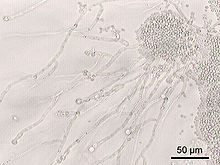Micobiota
Micobiota (sustantivo plural, no singular) es un grupo de todos los hongos presentes en una región geográfica particular (por ejemplo, "la micobiota de Irlanda ") o tipo de hábitat (por ejemplo, "la micobiota del cacao").[1][2]
Micobiota humana[editar]
La micobiota existe en la superficie y en el sistema gastrointestinal de los humanos.[3] Hay hasta sesenta y seis géneros y 184 especies en el tracto gastrointestinal de personas sanas. La mayoría de estos están en los géneros de Candida.[4][5]

Aunque se encontró que está presente en la piel y en el tracto gastrointestinal en individuos sanos, la micobiota residente normal puede volverse patógena en aquellos que están inmunocomprometidos.[6][7] Tales infecciones multiespecies conducen a una mayor mortalidad.[8]
Además, las infecciones adquiridas en el hospital por C. albicans se han convertido en una causa de importantes problemas de salud.[9] Una alta tasa de mortalidad del 40-60% se asocia con infección sistémica.[10][11][12][13][14][5] Los mejor estudiados son las especies de Candida debido a su capacidad de convertirse en patógenos en inmunocomprometidos e incluso en hospedadores sanos. Las levaduras también están presentes en la piel, como las especies de Malassezia, donde consumen aceites secretados por las glándulas sebáceas.[15][16] Pityrosporum (Malassezia) ovale, que depende de los lípidos y se encuentra solo en humanos. P. ovale luego se dividió en dos especies, P. ovale y P. orbiculare, pero las fuentes actuales consideran que estos términos se refieren a una sola especie de hongo, con M. furfur como nombre preferido.
Véase también[editar]
Referencias[editar]
- ↑ «LIAS Glossary». Consultado el 14 de agosto de 2013.
- ↑ «Mycobiota of cocoa: from farm to chocolate». Food Microbiology 28 (8): 1499-504. Dec 2011. PMID 21925035. doi:10.1016/j.fm.2011.08.005.
- ↑ Mukherjee, Pranab K.; Sendid, Boualem; Hoarau, Gautier; Colombel, Jean-Frédéric; Poulain, Daniel; Ghannoum, Mahmoud A. (February 2015). «Mycobiota in gastrointestinal diseases». Nature Reviews. Gastroenterology & Hepatology 12 (2): 77-87. ISSN 1759-5053. PMID 25385227. doi:10.1038/nrgastro.2014.188.
- ↑ Oral and maxillofacial surgery. Oxford: Oxford University Press. 2010. pp. 446, 447. ISBN 978-0-19-920483-0.
- ↑ a b «Small intestinal fungal overgrowth». Curr Gastroenterol Rep 17 (4): 16. April 2015. PMID 25786900. doi:10.1007/s11894-015-0436-2. «Small intestinal fungal overgrowth (SIFO) is characterized by the presence of excessive number of fungal organisms in the small intestine associated with gastrointestinal (GI) symptoms. Candidiasis is known to cause GI symptoms particularly in immunocompromised patients or those receiving steroids or antibiotics. However, only recently, there is emerging literature that an overgrowth of fungus in the small intestine of non-immunocompromised subjects may cause unexplained GI symptoms. Two recent studies showed that 26 % (24/94) and 25.3 % (38/150) of a series of patients with unexplained GI symptoms had SIFO. The most common symptoms observed in these patients were belching, bloating, indigestion, nausea, diarrhea, and gas. ... Fungal-bacterial interaction may act in different ways and may either be synergistic or antagonistic or symbiotic [29]. Some bacteria such as Lactobacillus species can interact and inhibit both the virulence and growth of Candida species in the gut by producing hydrogen peroxide [30]. Any damage to the mucosal barrier or disruption of GI microbiota with chemotherapy or antibiotic use, inflammatory processes, activation of immune molecules and disruption of epithelial repair may all cause fungal overgrowth [27].»
- ↑ Peters, Brian M.; Jabra-Rizk, Mary Ann; Scheper, Mark A.; Leid, Jeff G.; Costerton, John William; Shirtliff, Mark E. (2010). «Microbial interactions and differential protein expression in Staphylococcus aureus–Candida albicans dual-species biofilms». FEMS Immunology & Medical Microbiology 59 (3): 493-503. PMC 2936118. PMID 20608978. doi:10.1111/j.1574-695X.2010.00710.x.
- ↑ Lin, Yi Jey; Alsad, Lina; Vogel, Fabio; Koppar, Shardul; Nevarez, Leslie; Auguste, Fabrice; Seymour, John; Syed, Aisha et al. (2013). «Interactions between Candida albicans and Staphylococcus aureus within mixed species biofilms». Bios 84: 30-39. doi:10.1893/0005-3155-84.1.30.
- ↑ Zago, Chaiene Evelin; Silva, Sónia; Sanitá, Paula Volpato; Barbugli, Paula Aboud; Dias, Carla Maria Improta; Lordello, Virgínia Barreto; Vergani, Carlos Eduardo (2015). «Dynamics of Biofilm Formation and the Interaction between Candida albicans and Methicillin-Susceptible (MSSA) and -Resistant Staphylococcus aureus (MRSA)». PLOS ONE 10 (4): e0123206. Bibcode:2015PLoSO..1023206Z. PMC 4395328. PMID 25875834. doi:10.1371/journal.pone.0123206.
- ↑ Tortora, Gerald, J. (2010). Mibrobiology:an Introduction. San Francisco, CA: Pearson Benjamin Cummings. p. 758.
- ↑ Candida and Candidiasis (2nd edición). ASM Press. 2012. ISBN 978-1-55581-539-4.
- ↑ Weinberger, M (16 de abril de 2016). «Characteristics of candidaemia with Candida-albicans compared with non-albicans Candida species and predictors of mortality». J Hosp Infect 61 (2): 146-54. PMID 16009456. doi:10.1016/j.jhin.2005.02.009.
- ↑ «The human mycobiome in health and disease». Genome Med 5 (7): 63. July 2013. PMC 3978422. PMID 23899327. doi:10.1186/gm467. «Figure 2: Distribution of fungal genera in different body sites».
- ↑ «Candidiasis: predisposing factors, prevention, diagnosis and alternative treatment». Mycopathologia 177 (5–6): 223-240. June 2014. PMID 24789109. doi:10.1007/s11046-014-9749-1.
- ↑ «Review article: fungal microbiota and digestive diseases». Aliment. Pharmacol. Ther. 39 (8): 751-766. April 2014. PMID 24612332. doi:10.1111/apt.12665.
- ↑ «Human infections due to Malassezia spp». Clin. Microbiol. Rev. 5 (2): 101-19. 1 de abril de 1992. PMC 358230. PMID 1576583. doi:10.1128/CMR.5.2.101.
- ↑ «Microbial ecology of the skin». Annu. Rev. Microbiol. 42 (1): 441-64. 1988. PMID 3144238. doi:10.1146/annurev.mi.42.100188.002301.
Otros usos[editar]
- Hay una revista micológica revisada por pares titulada Mycobiota
